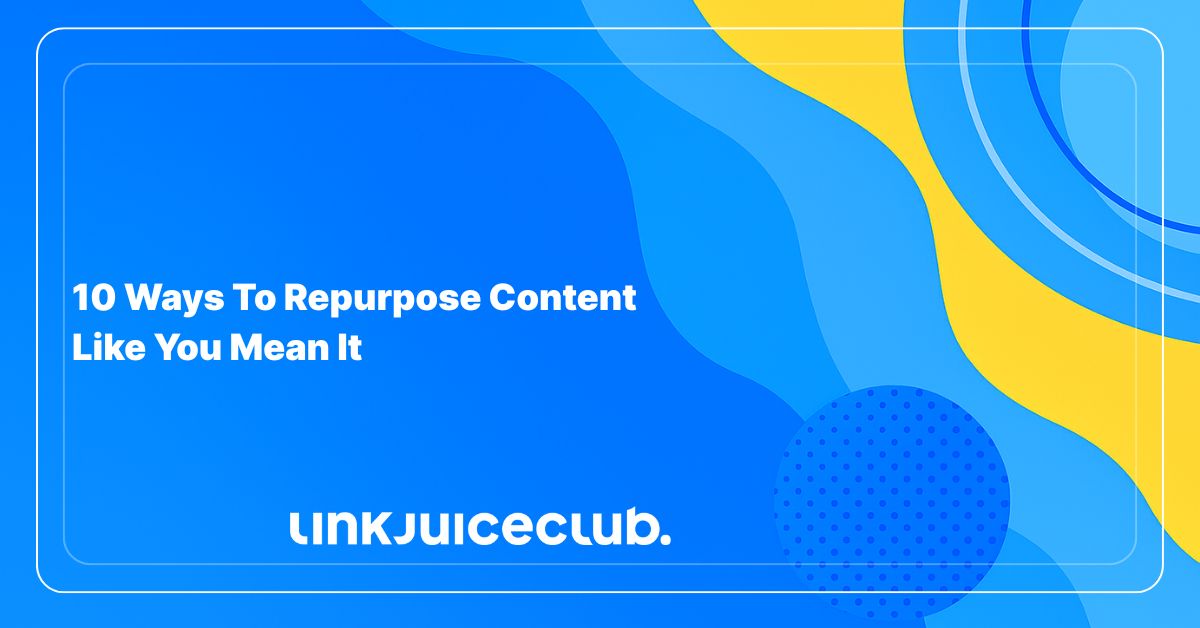
10 Ways To Repurpose Content Like You Mean It
Marketers like to pretend everything must be fresh. Completely new. Never-before-seen. In reality, most of them are secretly trying to squeeze four formats out of one blog post before their third coffee. The trick is making that look like strategy rather than survival.
To repurpose content is to take material that already works and adapt it for another purpose, platform, or audience. It saves time, multiplies value, and makes it easier to meet those publishing deadlines that seem to appear faster than they should.
High-performing content deserves a second life, especially when it already attracts search traffic, gets shared, or answers the kinds of questions your sales team’s been sick of repeating since last quarter.

The following methods are built on that simple fact: once is rarely enough.
- Convert One Blog Post into a Landing Page That Works for a Living
Every content team has a few blog posts pulling more weight than the interns. The ones that consistently pull traffic, answer search intent properly, and survive algorithm hiccups. These are ripe for elevation.
Turn one of those posts into a proper landing page. Trim the meandering intros. Bring in stronger subheadings. Swap the “fun facts” for actual benefits. Add an embedded case study or testimonial if available. This turns an informative post into something built to convert.
It’s still informative, but now it carries a clipboard and has KPIs.
✅ Works best when:
• The original post gets decent traffic already
• The topic aligns with a product or service
• Your PPC team is looking suspiciously at your content calendar
- Split Listicles Into Carousels, Like Slicing Salami
A well-structured listicle already has the makings of visual content. Each point gets its own card. Each card gets a header, a line of context, and an optional icon if someone on the design team owes you a favour.
Carousels are one of the more enjoyable ways to repurpose content. Platforms like LinkedIn and Instagram reward swipe-happy formats. Add a final slide with a link or call to action, then post it with a caption that doesn’t sound like a cry for help.
✅ Especially useful for:
• Listicles with five to ten punchy takeaways
• Posts that already include stats or short quotes
• Those Tuesday afternoons when engagement suddenly matters again
- Break Long-Form Guides Into Email Series That Look Like You Planned Ahead
Tutorials that stretch past 1,000 words often hide the outline for a tidy little email series. Five steps? Five emails. Seven tips? You know the drill.
No one opens a 1,500-word newsletter, but they will read a five-day series where each email is short, sharp, and one actionable point. It creates the illusion of a well-oiled content strategy and gives your audience something useful without asking them to read War and Peace on their phone.
✅ Perfect when:
• The topic includes steps, sequences, or timelines
• You want to nurture leads without daily begging
• Someone asked “Do we have anything for onboarding?”
- Turn Your Stats Into Infographics People Might Actually Share
Long blogs often bury perfectly good data. Pull those numbers out, give them a haircut, and dress them in graphic form. A strong statistic with a branded design has a better chance of getting shared, bookmarked, or embedded.
Infographics get passed around like biscuits at a board meeting. Particularly helpful when you’re pitching to journalists, partners, or anyone else who prefers their insights wrapped in rectangles.
✅ Solid choice when:
• You’ve got internal data or surveys
• The post includes multiple stats worth remembering
• You’re pretending this is for PR, but really it’s for Twitter
- Say It Again, Just Louder, on a Podcast
If you’ve got a thought leadership piece that sounds like someone finally snapped and told the truth, it will work as a podcast script. Add a co-host, and suddenly it’s a debate. Add a guest, and now it’s an expert roundtable.
Audio is an effective way to repurpose content, especially when the ideas are already shaped and structured. The mic just gives them new shoes. The structure stays, the delivery changes, and now you have a new format without new material.
✅ Useful when:
• You already recorded four takes explaining the blog out loud anyway
• The blog includes examples or opinions
• You need something for this month’s podcast slot and the mic is already plugged in
- Build an Internal Wiki From Your External How-Tos
A blog that explains how to use something is only a few tweaks away from being a support doc. Replace “you” with “users.” Strip out the rhetorical fluff. Add headings people might actually search.
Here, repurposing content creates operational value. Sales and support teams will thank you. Or at least stop sending passive-aggressive messages about “mixed messaging in the content.”
✅ Recommended when:
• You’ve published evergreen content with clear instructions
• The blog answers repeat questions from clients
• You’ve run out of patience for Slack threads about the same thing again
- Shave Off the Sharp Bits for Short-Form Video
Most blog posts contain at least three lines that would work on camera. A good stat, a bold opinion, or a one-liner that sounds like it came from someone with a podcast and a caffeine problem.
Short video is one of the fastest-growing formats to repurpose content. Record 30–60 second videos. No need for drones or slow motion. Just one point per video, said clearly, with a reason to keep watching or click through. Add a caption that doesn’t beg and a CTA that’s obvious.
✅ Effective when:
• The post includes strong takes or surprising facts
• You can say it without stumbling
• Your phone camera hasn’t been dropped recently
- Roll Up Long-Form Articles Into Threads With a Pulse
A blog that covers a topic in depth can become a thread that doesn’t waste anyone’s time. Start with a strong statement. Break each main idea into a post. Add visuals or GIFs if necessary. End with something that sounds confident.
Threads help content travel without pretending everyone’s going to read 1,500 words before breakfast. They build authority when done well, and they don’t require a graphic designer or a miracle.
✅ Best used when:
• The post explains a process, case study, or research
• The topic attracts debate or strong opinions
• You need something to tweet that doesn’t involve coffee or meetings
- Stitch Evergreen Posts Into Gated Guides
Three or four related posts can form the backbone of a downloadable guide. Merge them into a PDF. Add an intro that sounds helpful. Make it look like something people would save to their desktop and forget about.
Now you’ve got a lead magnet. Use it in exchange for email addresses. Mention it on your website. Email it to prospects and pretend it took weeks to produce. No one needs to know it was already written.
✅ Applies well when:
• The content stays relevant year-round
• Topics group neatly by theme
• You need something to justify your email form
- Refresh the Old Stuff So It Looks New to Everyone Except You
Some posts age like milk. Others age like sharp cheddar. Either way, if a blog used to rank and now it doesn’t, go back in. Check the keywords, update the stats, and reformat the headings. Tidy up the links. Swap any references that sound like they came from a time capsule.
Then republish it. Same URL. New timestamp. Google gets the signal. Readers get the update. Your metrics get the boost. Everyone wins. Except the version of you who originally wrote it while eating crisps and watching the clock.
✅ Reliable when:
• Rankings have slipped for something valuable
• The post earned backlinks in the past
• The rewrite takes less time than writing something new
All Useful Content Deserves a Longer Shelf Life
Content that delivers once can deliver again. Strong ideas carry weight across formats. Those who repurpose content keep those ideas active, visible, and productive.
This method works when applied consistently. It rewards planning and observation. The good material stays in circulation and it simply takes on a second job. Sometimes it is on a new platform, sometimes in a new format. Always working harder than the post that got forgotten after three days on the blog.
🧠 Good content behaves itself when you give it options.





